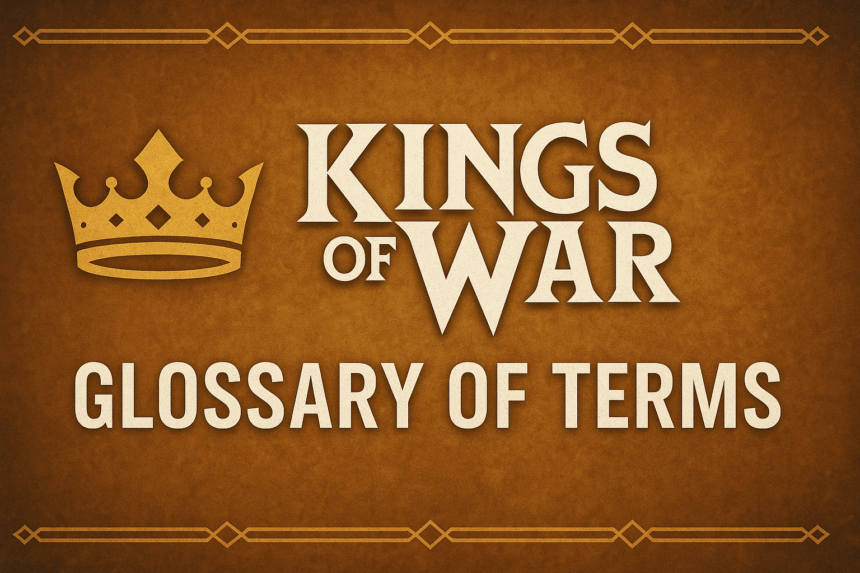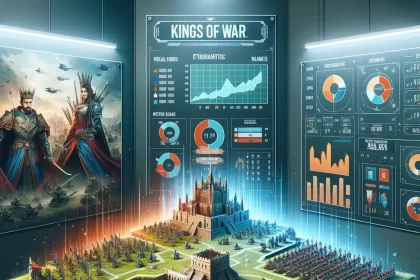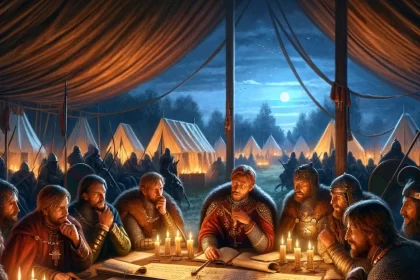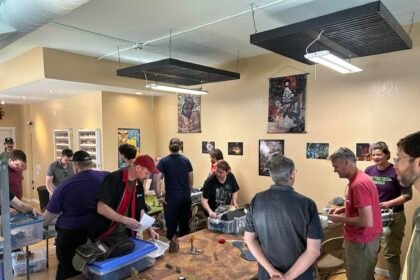This glossary collects commonly used terms in the Kings of War community. Definitions are based on community sources including Dash28.org, Goonhammer, DataandDice.com, the Counter Charge podcast, and historical content from Victoria Wargaming.
Alpha Strike
Definition:
An aggressive army style built around fast, hard-hitting “hammer” units that aim to strike first and break enemy formations. Often features cavalry, flyers, or monsters with Crushing Strength or Thunderous Charge.
Example in Use:
A Basilean list with Elohi, Knight regiments, and Julius is a classic Alpha Strike army—fast, high damage, and fragile if it doesn’t break through early.
Source:
Dash28: Just the Tips – Alpha Strike
Anchor
Definition:
A durable unit or formation placed centrally or defensively to absorb pressure and hold a key position. Usually features high Defense, high Nerve, and moderate threat.
Example in Use:
A Horde of Ironclad with Defense 6 and a Radiance of Life aura functions as an anchor to hold the middle of the board.
Source:
Victoria Wargaming (archived), Data & Dice
Anvil
Definition:
Similar to an Anchor but usually even tougher and less mobile. Designed to soak up damage and remain in place indefinitely.
Example in Use:
Earth Elementals with Defense 6, high Nerve, and Surge support are classic Anvils.
Source:
Victoria Wargaming, Goonhammer – Constructing an Army
Battleline
Definition:
The core block of an army meant to grind out fights and control space over several turns. Often slower but consistent.
Example in Use:
A Free Dwarf list with Shieldbreakers and Mastiff packs sets up a stable Battleline with good durability and output.
Source:
Goonhammer – Deliberations on Deployment
Buffer
Definition:
A support unit that enhances the performance of others—via Healing, Bane Chant, Rally, or Inspiring—without necessarily dealing damage.
Example in Use:
A Mage with Bane Chant behind a horde of Spearmen is acting as a buffer.
Source:
Data & Dice – 5 Traits of Winning Lists
Chaff
Definition:
Cheap, disposable units used to delay enemy threats, block charges, or force poor positioning.
Example in Use:
Gargoyles flying in front of a hammer unit to prevent it from being charged are acting as chaff.
Source:
Goonhammer – Deliberations on Deployment
Control Meta
Definition:
A meta where board control, scenario play, and delayed engagement dominate. Armies focus less on damage and more on contesting objectives and outmaneuvering opponents.
Example in Use:
Nightstalkers with multiple Phantoms and Void Lurkers can thrive in a control meta by contesting tokens and avoiding direct combat.
Source:
Dash28 – Ratkin Review
Deck Chair
Definition:
A unit that sits on an objective or in a safe zone with no intent to engage. Usually slow, low-cost, and resilient enough to score or deny.
Example in Use:
A regiment of Spearmen parked in a backfield forest holding a token until Turn 6.
Source:
Victoria Wargaming (archived), community slang
Diver
Definition:
A fast, usually solo unit designed to reach vulnerable enemy support units or war engines behind the lines. Prioritizes speed and reach over resilience.
Example in Use:
A Revenant King on Flying Wyrm diving into a War Trombone on Turn 2 is acting as a diver.
Source:
Victoria Wargaming, common competitive usage
Flanker
Definition:
A unit deployed on the side of the board with the aim of looping around enemy lines and threatening flanks or objectives.
Example in Use:
A regiment of Centaur Bray-Striders used to pressure a token on the far right flank.
Source:
Nick Williams, KoW Tactics: Unit Class
Flying Circus
Definition:
A list archetype built around multiple flying hammers. These armies rely on speed and manoeuvrability to overwhelm opponents, often ignoring slower ground troops. They excel at picking fights and collapsing flanks but can struggle with scenario play if they lack scoring bodies.
Source
Example in use:
An Elf list featuring three regiments of Drakon Riders and a couple of Dragon-mounted heroes qualifies as a flying circus. It floods the table with high-speed, Flying units that threaten charges across the board.
Source
Glass Hammer
Definition:
A hammer unit that hits extremely hard but has low Defence or Nerve, making it fragile if counter-attacked. Glass hammers deliver explosive damage but must avoid being hit back.
Source, Source
Example in use:
Orc Gore Riders (Thunderous Charge 2, Me 3+) are famous glass hammers. They charge with brutal force but have Defence 4+ and can crumble if charged in return. Mantic notes that orcs are a “glass hammer” army, hitting hard but relying on numbers to compensate.
Source
Grind / Grindy
Definition:
An army style centred on durable units that outlast the opponent through sustained combat. Grind lists stack high Defence, Regeneration or Lifeleech and rely on healing to win attrition wars. They typically move slowly and lack alpha-strike potential.
Source
Example in use:
A Dwarf army with multiple Ironclad hordes (Def 6+, high Nerve) supported by Stone Priests casting Heal qualifies as a grind list. Its goal is to sit on objectives and wear down enemies over several turns.
Source
Gunline
Definition:
A list built around ranged damage output. Gunlines include multiple war machines, ranged infantry units and casters with Lightning Bolt or Fireball spells. They aim to thin or destroy enemy forces before melee. Gunlines can struggle with scenario scoring and are vulnerable to fast, resilient armies that close quickly.
Source
Example in use:
Kingdoms of Men lists with three or four Cannons, two Mortars and hordes of Crossbowmen create a gunline capable of delivering devastating ranged salvos. To compete in scenarios, the army may include a few cheap cavalry units for objective grabs.
Source
Goonhammer
Definition:
A community website featuring tactical articles, army reviews and hobby content for wargames, including Kings of War. Many glossary definitions and meta analyses in this document are drawn from Goonhammer articles.
Example in use:
The site’s article “What is Chaff and How to Use It?” provides a detailed explanation of chaff tactics and introduces the concept of thick chaff.
Source
Hammer
Definition:
A unit designed to deal heavy melee damage, typically paired with Chaff or Surge to ensure it reaches ideal targets. Lacks staying power.
Example in Use:
A Horde of Abyssal Horsemen charging with Thunderous Charge 2 is acting as a hammer.
Source:
Dash28 – Just the Tips: Alpha Strike
Horde / Swarm / Trash
Definition: A list style that overwhelms the battlefield with a large number of cheap units (often 15–20 drops). These armies sacrifice individual unit quality for sheer numbers and board control. Data & Dice calls this archetype “Trash” and notes that such lists flood the table with unit strength and threaten to win by scenario even if they lose many models.
Example in use: A Goblin army with multiple Rabble regiments, Sharpsticks, Trombones, and Mawbeasts can field 18–20 units for under 2,000 points. It overwhelms opponents through attrition and scenario play.
Source: Data & Dice archetype analysis; Goonhammer army styles.
Heal / Healing
Definition: A spell that removes damage from friendly units; many armies rely on healers to sustain anvils and hammers. Healing spells are part of a broader support toolkit described in Data & Dice’s list‑building guide.
Example in use: A Druid with Heal (5) supports Sylvan Kin Tree Herders by removing damage each turn, turning them into effective anvils.
Source: Data & Dice list‑building guide.
Inspiring
Definition: A special rule that lets nearby friendly units re‑roll failed Nerve tests to avoid routing. Most armies include several Inspiring characters because they improve survivability.
Example in use: A Basilean High Paladin with Inspiring stands behind two Knight regiments. If either regiment fails a Nerve check, the opponent must re‑roll; this increases the chance the knights stay on the table..
Source: Mantic’s beginner’s guide.
Leader
Definition: In Data & Dice statistics, a “Leader” is any unit with the Inspiring rule. Leaders are vital for keeping troops steady; however, the term is mainly used in analytic tables rather than mainstream conversation.
Example in use: In a CoK Australia analysis, each army’s number of Leaders (inspiring units) is recorded to show how much reroll support a list includes.
Source: Data & Dice classification.
Pest
Definition:
In Data & Dice analytics, a “Pest” is any unit with the special rules Strider or Pathfinder (ignoring terrain penalties). Pests disrupt enemy plans by exploiting difficult terrain and flanking through forests or obstacles. The term is seldom used outside data analysis but describes units that excel in terrain.
Example in use: Forces of Nature Forest Shamblers have Pathfinder and a low point cost; they are classified as Pests because they skulk through terrain to threaten flanks and war machines.
Source: Data & Dice classification.
Source:
Victoria Wargaming, community slang
Plinker
Definition:
A unit that does low but reliable ranged chip damage, often from long range or multiple weak attacks. The goal is to cause early wounds, disrupt healing, or finish weakened units.
Example in Use:
War-Trombone, Heartpiercers, or Herneas’ rangers dealing 1-2 wounds per turn over time.
Source:
Dash28 – Best Individuals
Shock
Definition: A Data & Dice category for high‑impact melee units with at least 8 Attacks and good Melee values. It captures the “hammer” role in their statistics; however, players more commonly refer to such units simply as hammers.
Source: Data & Dice tournament analysis table.
Swarm
See Horde / Swarm / Trash above.
Support Elements
Definition: Heroes, war engines, artillery or spellcasters that provide buffs, inspiring, healing or ranged support. They aren’t primary combat units but are essential for synergy. Data & Dice emphasizes building lists around hammers, anvils and scorers, then filling remaining points with support elements like inspiring heroes, casters with Bane‑Chant or war engines.
Example in use: A Druid (Inspiring, Heal (5)) and Wiltfather (surge caster) in a Forest Kin list act as support elements, backing up the main line and enabling charges.
Source: Data & Dice list‑building guide.
Thick Chaff (Thicc Chaff)
Definition: More durable or dangerous chaff units that can survive longer and even threaten weaker enemy units. Thick chaff may have decent combat stats, higher Defence or better Nerve, allowing them to contest objectives and excel in chaff‑on‑chaff combatsgoonhammer.comdash28.org.
Example in use: Ogre Warriors or Large Infantry like Lizardmen Tyrants can serve as thick chaff. They cost more than standard chaff but can hold up enemy hammers for a turn or two and even deliver flank charges against other chaff units.
Source: Goonhammer chaff article; Dash28 “Hook Book”.
Trash
Definition:
An army archetype made of many cheap units with low stats but high board control. Trades efficiency for mass and resilience via redundancy.
Example in Use:
A Goblin army with multiple Rabble regiments and Mawbeasts overwhelms the opponent by forcing hard choices and filling the board.
Source:
Data & Dice – Six Archetypes







